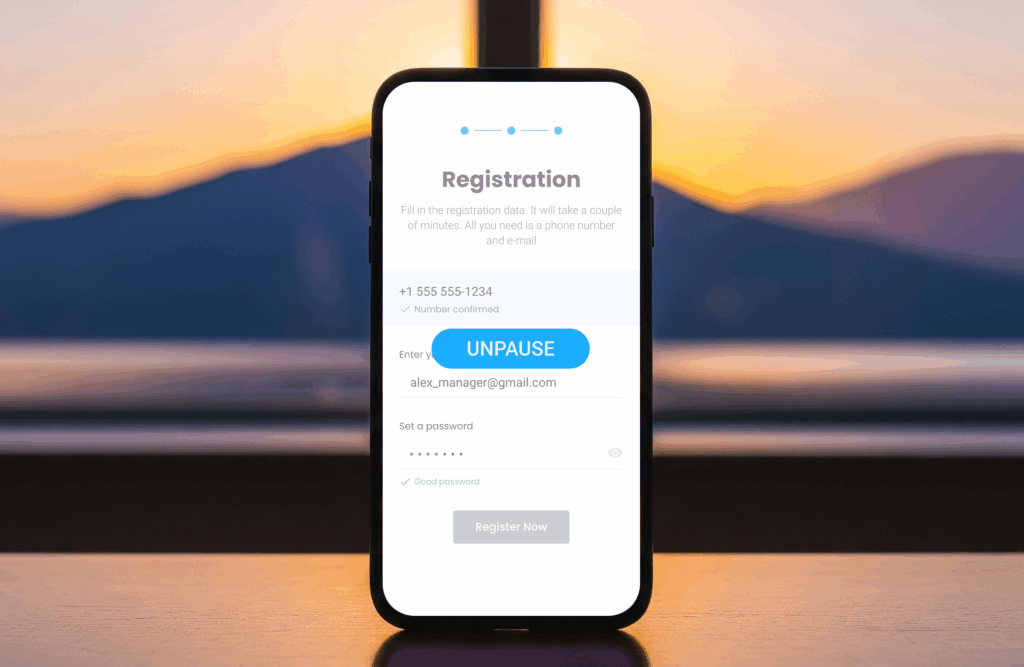From Sign-Up to Stickiness: Designing a Customer Experience That Nudges FinServ Users to Act

Customer journeys are often built to acquire—not activate. The content is compelling, the sign-up flow is sleek, but the customers are left hanging. There’s no real hand-holding or guidance, often leaving users feeling frustrated at the prospect of having to make complex financial decisions without any real support.
This is the Customer Experience Gap—the vulnerable space between conversion and commitment, where too many users get stuck, jeopardizing your Customer Acquisition Cost (CAC) investments and leaving them, at best, unproductive. To bridge that gap, FinServ leaders are turning toward enhancing the customer experience by introducing smart prompts intended to guide users through early decision making, reduce friction, and encourage them to take action. Designed using behavioral insights, they help users feel confident, supported, and in control.
In this post, we’ll explore how these micro-moments can transform the customer acquisition process into a meaningful experience—and turn passive web traffic into engaged long-term customers.
The Danger Zone
Unfortunately, many financial services web experiences offer the same generic journey to every user—a cookie-cutter sequence of steps filled with industry jargon that feels more like a to-do list than a conversation. Users are often asked to navigate Terms and Conditions, complex product content, and unfamiliar processes without context or support. This “sea of sameness” creates an experience that is not only uninspiring, but makes users less confident in their choices.
According to a 2023 report by PwC, 59% of financial services customers say they would switch providers for a more personalized experience, yet only 34% believe their current provider understands their unique needs. Additionally, Edelman’s 2024 Trust Barometer found that financial services rank among the least trusted industries globally, with only 53% of consumers expressing confidence in their financial institution.
This lack of trust leaves most financial institutions seeking a way to create more stickiness with their customers. It’s no longer enough to offer a competitive rate of return. Brands seeking real return for their Customer Acquisition Costs (CAC) are breaking away from the monotony by recognizing the unique needs, concerns, and goals of their users–all while delivering support every step of the way.
Personalization, not Pressure
Smart prompts are personalized, timely moments strategically placed throughout the customer journey to help users take action with confidence. Think of them as intuitive nudges that aim to reduce friction and make the complexity of financial decision making feel more manageable. Smart prompts meet individuals where they are, offering support tailored to their unique behaviors and needs.
During the acquisition phase, smart nudges act as confidence builders and friction reducers. Prospective customers are often evaluating several financial institutions at a time, this is where personalization becomes a differentiator. For example:
- Using contextual dynamic CTAs like “No minimum deposit required” or “Start with just $5” lower perceived risk and drive conversions.
- Guided or step-by-step content during sign-up can clarify why certain data is needed (“We ask for income range to suggest personalized plans”) helps ease anxiety and keep users moving forward.
- Benefit Framing: Highlighting the benefits that connect with users, “Join over 500,000 people saving toward their first home”—builds social proof and emotional resonance.
Once a user is “acquired,” the real work begins.
In the authenticated experience, personalization is no longer a feature. It’s the foundation for building trust, accelerating activation, and improving lifetime value.
Once a user is logged in, you’re able to connect their data with a personalization engine that leverages real-time behavioral signals including how often someone logs in, where they click, and what actions they take or avoid. Institutions can then deliver real time content that is hyper personalized, not only improving your cross-sell/up-sell ability, but creating a connected customer experience that will foster the trust and stickiness companies are working so hard to achieve.
- Instead of a cold “fund your account” button, a prompt might say, “You’re 80% of the way there—add $20 to unlock personalized insights.”
- If a user sets a savings goal, but stops contributing, the system could surface a message like, “Life happens—want to adjust your timeline?”
- For someone who’s never explored their credit score, a nudge could read, “See how your credit’s doing—we’ll break it down for you, no jargon.”
These micro-moments reduce cognitive load and emotional stress by making the path forward feel obvious and achievable. More importantly, they show the user that the brand is paying attention—not just to what they’re doing, but to what they might need next.
From Transactional to Trust-Building A Human-Centered CX
In the “before” state, a customer might complete sign-up and be dropped into a generic dashboard. In the “after” state, their next steps are dynamically generated based on their behavior, goals, or profile. If a user skips funding their account, they don’t get a cold prompt—they get a contextual, supportive nudge like:
“You’re almost there. Most customers fund within 3 days—want a quick walkthrough?”
Money decisions often trigger anxiety. But with smart nudges, the platform feels more like a coach than a system. Educational tooltips, progress indicators, and step-by-step onboarding convert uncertainty into momentum. For example:
“Based on your transaction history, setting a $100/month savings goal could help you hit your vacation goal by spring.”
Without smart moments, engagement tends to fade fast after sign-up. But with the right triggers—round-up savings suggestions, personalized insights, or celebratory milestones—users stay connected. These small interactions deepen the relationship and reduce churn.
Investing in CX = better investments in CAC
Customer Acquisition Cost (CAC) isn’t just a marketing metric—it’s a reflection of how well your brand earns trust, removes friction, and turns curiosity into commitment. When your customer experience is fragmented, impersonal, or confusing, your CAC doesn’t just go up—you lose the long-term value those customers could’ve brought.
By contrast, investing in CX—especially through smart, behaviorally informed prompts—amplifies the value of every dollar spent on acquisition. Here’s why:
- Higher Activation = Lower Waste
- If 100 people sign up and only 20 engage, your CAC is 5x higher than it should be. Smart prompts that guide users through their first meaningful actions help ensure more of your acquired users convert into active, loyal ones.
- Stronger Retention = Greater Lifetime Value (LTV)
- Customers who feel supported are more likely to stay. Small moments of personalization build trust and emotional loyalty, which in turn improves LTV—a key offset to CAC.
- Fewer Drop-Offs = More Efficient Spend
- Nudges reduce abandonment by meeting users in the moment they need help. This makes every paid click, every impression, and every referral more efficient.
Where to Start
CX is a journey often informed by data driven optimizations and AB testing. You’re not going to get everything right on the first try and that’s okay. Start with one place where users often drop out of their journey—and try to build a smarter experience around it. From there, you can scale. Layer in more prompts across the journey. Test variations. Tune for tone, timing, and personalization. Think of it not as a product roadmap, but as an experience roadmap—one built not just to convert, but to connect.
The brands that win in financial services won’t be the ones with the flashiest banners. They’ll be the ones that turn every interaction—every nudge—into a moment of trust.
Ready to Close Your CX Gap? Let’s Talk.
CX SpotCheck – a no cost engagement we use to help you rapidly understand 2 things:
- Where opportunities exist in your customer experience
- Who SH/FT is and how we work
Think of it as a getting to know you interview with the added benefit of our SH/FT strategists providing actionable Value.
It’s Easy: Sign an NDA, answer five quick intake questions, and within 5 business days we’ll uncover 3–5 no-brainer fixes hiding in your public-facing customer journey. You’ll get the insights during a 60-minute collaborative video call, plus prioritized opportunities you can implement immediately. Limited to the first 10 enterprise brands this quarter.
Sign up here and let’s turn your CX into your strongest growth lever.





